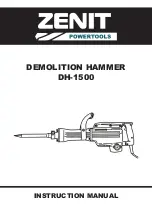
Manual Revision: June 20
Copyright © 2013-2020 Pirate Brand®, All Rights Reserved
10
C-Series Jr - 0.5 / 1.0
Cu Ft
User’s Manual
PRESSURIZING THE ABRASIVE BLASTER
Before pressurizing the Abrasive Blaster make sure the
following conditions occur:
• All “BEFORE YOU BLAST” procedures have
been followed.
• The Inlet Shut-Off Valve is closed.
• The Inlet Valve Petcock is closed.
• The Remote Control Handle is released.
• All hose connections are secure and have a safety clip
installed.
• The Abrasive Blaster is set up in a safe and level location
where all people in the vicinity are aware of its presence.
• All necessary safety equipment is present and being
worn by all people in the vicinity of the Abrasive Blaster.
• Only personnel who have been thoroughly trained and
have read and understand the manual are in the vicinity
of the Abrasive Blaster
When these conditions are met, turn on the compressed air
source and open the Inlet Shut-Off Valve on the Abrasive
Blaster. The Abrasive Blaster is now ready to begin blasting.
DANGER
: Never perform any maintenance or
attempt to open the Abrasive Blaster in any way
while it is pressurized. The violent release of
compressed air and propelled objects will cause
serious injury or death.
DANGER
: Never supply compressed air
exceeding 150 PSI (10.3 BAR) to the Abrasive
Blaster.
WARNING
: The Blast Hose may kick back when
Remote Control Handle is activated. Be
prepared and brace yourself for kick back.
Blast Hoses will normally kick back erratically for
a short time when the Abrasive Blaster is started.
WARNING
: All those who will be in the area
while blasting is to occur must be properly
trained, read the manual, and wearing safety
equipment to protect from the hazards described
by the WARNING and DANGER labels located
on the Abrasive Blaster. If any labels are worn
or missing they must be replaced.
WARNING
: 100 PSI Minimum. Failure to provide
a constant air supply of at least 100 PSI can
cause excessive wear to multiple components
and the control system to operate improperly.
USING THE ABRASIVE BLASTER
After pressurizing the Abrasive Blaster, it is ready to begin
blasting. Fold down safety flap lever lock and squeeze the
Remote Control Handle to start the flow of abrasive and
compressed air. Adjustments to the air/abrasive mixture
can be made by swinging the handle on the Metering
Valve. There will be a delay between a change made at
the Metering Valve and what comes out of the Nozzle
depending on the length of Blast Hose being used.
To stop the flow of compressed air and abrasive,
release the Remote Control Handle and blasting will stop
after a short time. How long it takes for blasting to stop
will depend on the length of Blast Hose being used. The
pressure vessel will automatically exhaust through the
Diaphragm Valve causing a rush of compressed air that
can propel any loose objects, debris or spilled abrasive at
nearby personnel. For this reason, personnel must not be
located near the Abrasive Blaster when blasting is taking
place.
DANGER
: Airborne particles produced by
abrasive blasting can cause respiratory disease.
All persons operating or located near the blasting
site must wear approved NIOSH / OSHA
approved breathing equipment. Never use
abrasive containing silica.
DANGER
: Never stand near an Abrasive Blaster
when it is in operation. The release of the
Remote Control handle will cause a sudden
release of compressed air from the Diaphragm
Valve without warning. Only Adjust the
Metering Valve after the Abrasive Blaster has
completely depressurized.
WARNING
: Only personnel thoroughly trained in
abrasive blasting should operate the Abrasive
Blaster. This manual only provides basic
information on how to safely operate the features
of Pirate Brand® CPR Series Abrasive
Blasters.
WARNING
: Never point the blast Nozzle at
yourself, other people, or the Abrasive Blaster.
WARNING
: Never use the abrasive blaster
without a nozzle securely installed in the blast
hose nozzle holder
WARNING
: The Choke Valve must be completely
open when blasting or damage to equipment will
occur.
Operating Procedures
Blasting











































